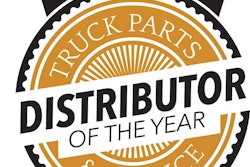By Bill Wade, Wade & Partners
First, my view as a former Notre Dame Philosophy (not Theology) major: Many people worry that artificial intelligence will make us feel inferior. We really should feel an inferiority complex every time we look at a flower. Nonetheless …
Algorithms are revolutionizing the heavy-duty omnichannel service future
I have listened closely to all sorts of futurists and seers to try to get some real insight on where trucking and its support functions (like parts distribution and service) may be headed. Autonomous trucks, hydrogen/electric power, drone-based delivery … YAWN... not while most of us are still active in this business.
The real action in the next ten years is in customer-facing operational efficiency — any system that promises to keep whatever designers think up on the road. As I see it (grossly simplified):
DATA ► IoT (Internet of Things) onboard sensor → satellite-based communicator → predictive performance analysis → OTR driver instruction ↔ selected truck servicer → autobilling ↔ automated payment, records and performance analyses → OEM designer.
Five years ago, the average high-end car already had roughly seven times more code than a Boeing 787. As we approach the next analytics-driven operations stage, heavy trucks will become productive data centers and, ultimately, components of a larger mobility network.
The whole system, as well as the extensive network of physical product/service suppliers, depends on artificial intelligence (AI) and machine learning algorithms. These technologies, along with advances in blockchain, are the basis to unlock the ultimate service goal — a product targeted for each individual customer.
While new products and technology designed to assist and enhance the wholesale distribution industry have continued to evolve, distributors report their top challenges remain the same. The short-term problem they most expect to face in 2019 is the increasing volatility of demand due to new competition, new customers and digital e-commerce (79 percent), according to supply chain solution company Blue Ridge.
Algorithms and analytics are our new friends!
AI and machine learning are revolutionizing omnichannel distribution, a trend now sprouting in the heavy-duty truck parts and service world. These changes seem to be based on growing trends in consumer markets, recognizing customer ‘personas’ and their skyrocketing personal expectations.
Wade & Partners has been keenly interested in how legacy-based customer care, IT infrastructure and supply chains can remain responsive and grow. Louis Columbus is an enterprise software strategist who recently did a very credible boil-down of various effects of algorithm-based analytics on business. He identifies a number with which we absolutely agree:
- Machine learning is enabling brands, distributors, OES dealers and service providers to more precisely define customer ‘personas,’ including their buying preferences and sensitivities. Leading omnichannel retailers are successfully using AI and machine learning today to personalize customer experiences to the single consumer level. They’re combining brand, product preferences, location data, content viewed and transaction definitions for each key narrowly defined customer segment. The needs of a construction vocational owner-operator are certainly way different from those of a large over-the-road fleet maintenance vice president.
- Algorithms make it possible to create propensity models, which will be invaluable for predicting which customers will act on a promotional, bundling or pricing offer. Propensity models have proven to be very effective at increasing customer retention, upselling or cross-selling, while reducing churn. Our research shows businesses excelling at omnichannel today rely on propensity models to better predict customers’ preferences and assign importance to whether past behavior will lead to future purchases.
- Individual customer price optimization is now possible using machine learning, allowing management to factor-in brand and channel preferences, previous purchase history and price sensitivity to optimize profit yield per transaction. Brand defenders are saying that cloud-based price optimization and management apps, based on rapid advances in machine learning, are easier to use and more powerful than ever before.
- Omnichannel leaders are redesigning IT infrastructure and integration so they can scale customer experiences.Remember, these trends are largely the result of the Amazon effect on personal expectations. Even with our legacy-centric supply chain maps, succeeding with omnichannel takes an IT infrastructure capable of flexing quickly in response to change in customers’ preferences while providing scale to grow. Every element of a supply chain, from supplier, marketing group, service management and private label sourcing to scheduling, manufacturing and fulfillment, needs to be orchestrated around customers.
- Customer-centric distributors rely on AI and machine learning to digitize their supply chains, enabling on-time performance and fueling faster revenue growth. For any omnichannel strategy to succeed, supply chains need to be designed at scale to excel at time-to-market and time-to-customer performance. Important? 54 percent of leading distributors and retailers pursuing omnichannel strategies say that their main goal in digitizing their supply chains was to deliver better customer experiences.
A recent flood of new capabilities engineered into advanced Class 8 tractors makes predictive maintenance possible (probable). Predictive maintenance powered by AI and machine learning are improving sales loyalty by predicting which parts and service will lead a customer to buy.
Analyzing previous truck owners’ (fleets to owner-operators) buying behavior using machine learning provides insights into which content needs to be personalized and presented to create a long-term relationship. Predictive content analytics is proving to be very effective in B2B selling scenarios and is moving into consumer products as well.
Not simply demand — value denial is opportunity wasted
Use of ‘algorithmic assists’ is uncovering another profit development opportunity we call “value denials.” These are products or services that are both desired and feasible but are not being supplied to the market. This concept combines newly discovered insights into demand and potential supply to create innovative market disruption.
Most value denials are business opportunities. A real easy example, every change or innovation creates new value denials:
- People wanted to buy music à la carte and keep 10,000 songs on their computers. Well, they got that, but there was a value denial: the digital music wasn’t portable.
- So along come the MP3 player and the iPod. But those innovations uncovered a new value denial: people also want to plug their players into their stereos.
- Well, this was pretty easily fixed, but playing your MP3s on your stereo uncovers yet another value denial: MP3s are compressed and just don’t sound as good as CDs.
Even when I have instant access to all music anywhere and anytime through the “jukebox in the sky,” there will still be a value denial — how will I know what to listen to? (I will need a private disc jockey to help arrange my listening and maybe to shape my tastes.) Once we have access to this whole new encyclopedia of operating process and individual preferences, distributors and service providers still need to knit together new ideas and innovative approaches.
What is currently available to turn operational understanding into profit?
It is not as simple as ‘80/20’ rules that we learned the first week in the business. We know that when customers and products are analyzed and managed by data points such as net profit at line item granularity (WayPoint), we can get 10 percent of our business elements to generate 200 percent of peak internal profits.
In a similar manner, the bottom 1 percent of customers on a profitability ranking at the customer/branch/group-member level can provide real additional advantage for group program design and even acquisition due diligence.
I feel that knowing the components of net-profitability for every line item (SKU, supplier, order history, customer, and sales territory) allows an unprecedented recognition of big, hidden profit/loss cross-subsidies, as well as quickly-implemented elimination of this ‘noise.’
The cross-subsidies are symptoms of root causes that financial numbers can’t see, but are crystal clear with algorithmic help. Innovating with the insights around the root causes will create a new, true measure of customer value and reduce total service costs.
The “age of algorithms” is still in its formative stages. There are, however, already plenty of accessible, affordable tools that can automate your operations and sales management to help you get a grip on your tech investments and improve customer-facing efficiency and elevate the customer experience.
Bill Wade is a partner at Wade & Partners and a heavy-duty aftermarket veteran. He is the author of Aftermarket Innovations. He can be reached at [email protected].










